Written By Glen Beadon
STATISTICS:
Extension: San Fernando to Siparia 16 Miles 5 chains
Initial 1910 Estimate for construction: £141,891
Consulting Engineers Estimate Cost: £ £196,906
Start date for construction: April 1912
Official opening date of extension: 17 November 1913 Final Cost: £166,837
Chief Resident Engineer & General Manager of Railways: Horace Richard Marwood
John William Tomlinson became Acting General Manager during construction in 1912.
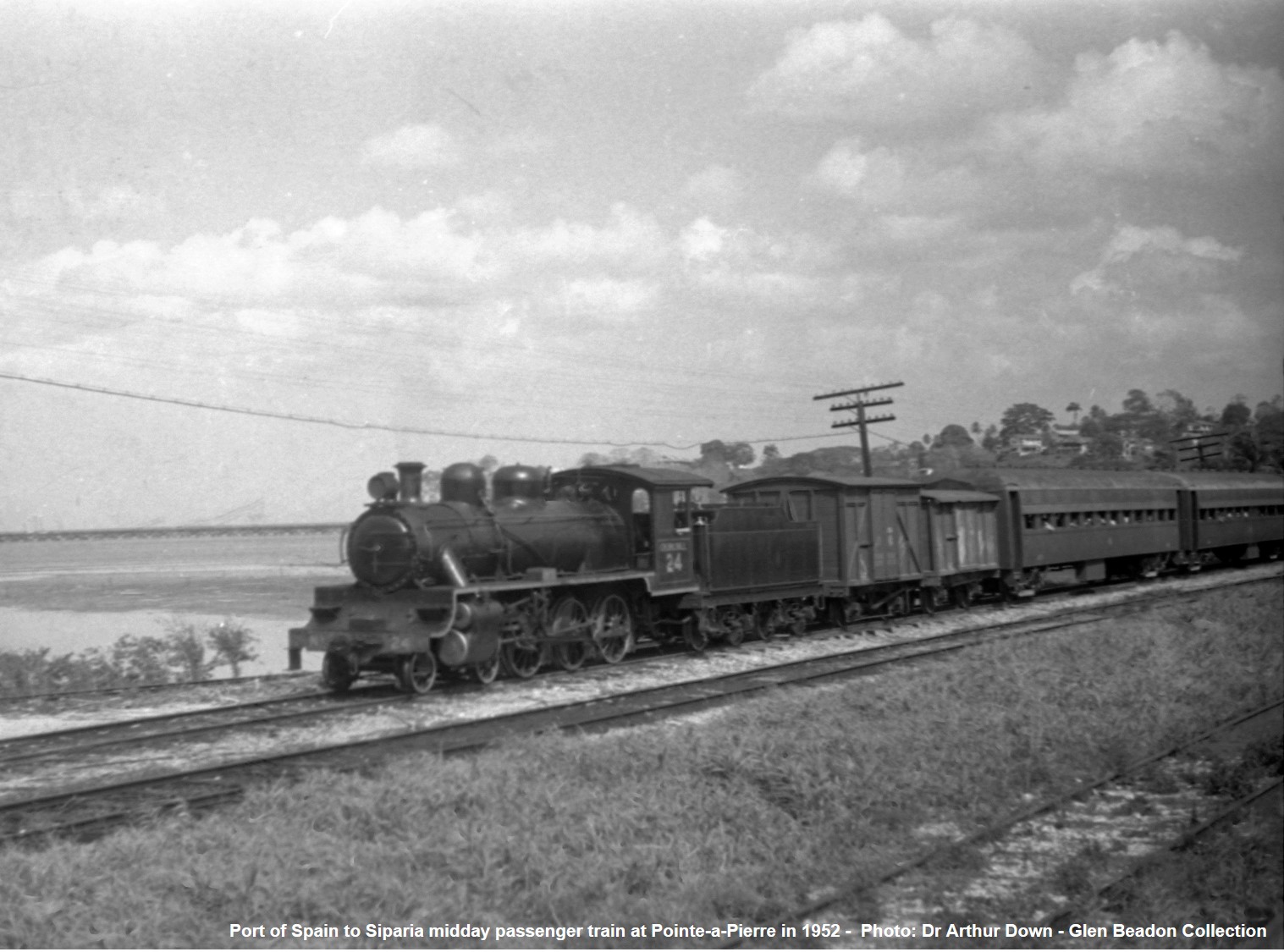
HISTORY:
In the three years leading up to the outbreak of the Great War the Trinidad Government Railway planned several large and important railway extensions and improvement projects. The Railway extensions included, Railway No.1 from Tabaquite to Rio Claro, Railway No.2 from San Fernando to Siparia, Railway No.3, The Guaracara-Cipero Junction Line with associated works at Princes Town, and enhancements to the Jordan Hill Branch of the Cipero Tramway.
Regarding improvement projects, there had been for a long time, proposals to improve Port of Spain Railway station which had hitherto not kept pace with the expanding railway.
In this blog I shall concentrate on Railway No.2 “The San-Fernando To Siparia Extension Railway”
The preliminary surveys for the railway extensions were authorised in February 1908, commenced in June of that year, and completed in March 1909. Slow progress of these surveys was due to difficulties in getting together a suitable staff, to sickness among the staff, to unusually heavy rains, and particularly to the dense vegetation of the country traversed. A small portion of the time was also occupied in finding a route for an extension beyond Siparia to Erin, which was not contemplated when the surveys were first authorised. This was done at the insistence of His Excellency the Governor, Sir Henry Jackson, who was of opinion that the opportunity afforded by the presence of the surveying staff should not be missed.
The story of the Siparia railway is closely linked to the development of Trinidad’s oil industry in the early part of the 20th century. A previous proposal for a railway to Siparia was rejected in 1909, the matter had engaged the attention of the Colonial Government but was initially dropped for financial reasons. In June of 1910, however, members of the Legislative council debated once again the pros and cons of a line to Siparia from San Fernando. The argument for this line became even more compelling once oil had been discovered in large quantities across the southern district of Trinidad. It was thought practicable as a matter of priority to continue the San Fernando line onward to Siparia.
In 1910 the General Manager of the Trinidad Government Railways, Mr. Horace Marwood, having been placed in charge of the works for the Railway Extensions, made his way to England on 13 June to discuss plans and estimates with the consulting engineers, Messrs. Gregory Eyles & Waring. During Mr. Marwood’s absence from the Colony and for the duration of planned works of the extensions, Mr. John W. Tomlinson, the Locomotive Engineer, was appointed to act as General Manager for administrative duties. However, Mr. Marwood remained vested with absolute powers over the railway department.
The estimates for the cost of construction already approved by the Legislative Council was in the order of £141,891.
One very interesting aspect of the originally surveyed line between San Fernando and Siparia was the inclusion of two tunnels. The first was 4 ¾ chains (313.5 feet) in length through a saddle between the hospital and the doctor’s house at San Fernando. Through most of its length the proposed tunnel would have been built under San Fernando’s public recreation lands, Paradise Estate, on which it would have been desired to encroach as little as possible. The second tunnel 3 ¾ chains (247.5 feet) in length was proposed to occur just before the originally projected Siparia station was reached. In both cases, at the recommendation of the Consulting Engineers in London, tunnels were avoided.
At San Fernando it was instead found expedient to divert the line around the foreshore and at Siparia the line was instead deviated by 1/8 of a mile placing the station on the opposite right bank of the ‘Lava Pies Ravine’, which placed the station in a more suitable position for any further extension towards Erin, as previously intended, and mentioned in council paper No.33 of 1909. The extension, as we now know, was never built.
Another interesting construction aspect of the proposed plan was the use of cement concrete as opposed to bricks. This was proposed not only for the new Port of Spain station building but also to be adopted for the construction of abutments and culverts along the new lines owing to the general absence of suitable building stone, and the lack of experience in brickmaking in Trinidad.
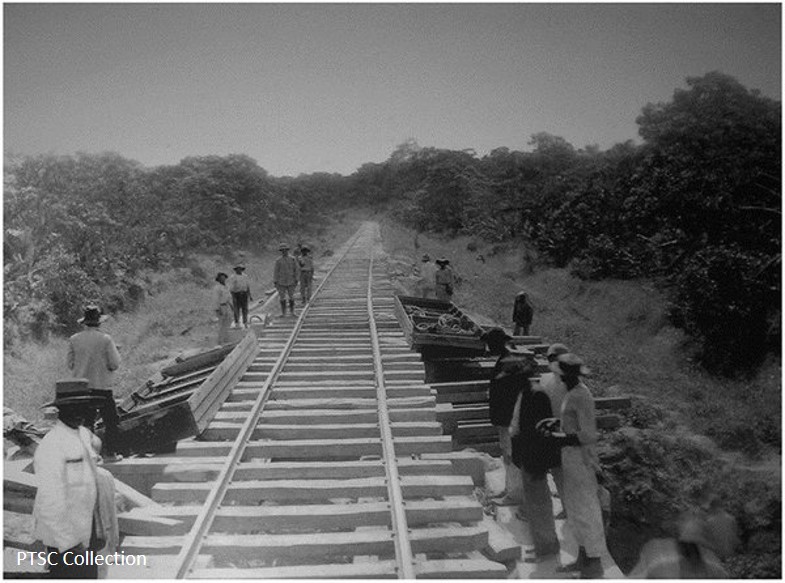
Image courtesy of the PTSC collection: The building of the Siparia Railway Extension in 1912
Accordingly, Ordinance No.6 of 17 March 1912 authorised construction of the Siparia Railway and Ordinance No.28 of 26 June 1912 authorised construction of the San Fernando to Siparia Railway. The need for two Ordinances for what appears to be the same railway provides a clue of the great difficulties which existed between the Government and the Cipero Tramway Commissioners in reaching agreement over how to manage the joint operation between cane and passenger trains. Negotiations in the 1910 London agreement between the two went on for some time before a final compromise was eventually reached.
Work began on the southern portion of the Siparia Railway Extension during April of 1912. Work on the northern part of the line from San Fernando through The Cross, Victoria, Corinth, Golconda and Debe was delayed until final agreement was reached with the Cipero Tramway Commissioners.
The account of the San Fernando to Siparia Railway is remarkably interesting because it effectively marks the final chapter in the story of the Cipero Tramway. The tramway that had opened the railway adventure in Trinidad was finally dissolved through the issue of Ordinance No. 31 of 1912.
The Cipero Tramway shall be covered in more detail another time but suffice to say that it bears relevance to the Siparia line in that a portion of it (the Cipero Line) had to be acquired by the government in order to link San Fernando to Golconda and onwards to Debe, Penal and Siparia.
Ordinance No.31 of 1912 went on to authorize the construction of the San-Fernando-Siparia Railway and at the same time granted authority for the Trinidad Government Railway (TGR) effectively to absorb most private lines in the Naparimas, including the Cipero Tramway.
A series of Ordinances were to follow in order to authorize the takeover of existing tramroads, the conversion to railways of said tramroads and the construction of new sections of lines. All of this was to follow over several years and is not significant to this article.
The transfer of the Cipero Tramway from the control of the Commissioners to the Government took effect from 30th June 1912 enabling a start to be made on the complicated works on that section of the line on 1st July 1912. This takeover was an enormous undertaking by the Government at a time of the last great railway expansion in Trinidad. Not only was the Tabaquite to Rio Claro and the San Fernando to Siparia lines under construction but now, at the same time, there were improvements and modifications which had to be carried out so that acceptably safe operating arrangements could be observed across the busy railway lines which traversed the Naparimas.
Construction of the new railway from San Fernando began at a point on the Trinidad Government Railway, 250 feet or thereabout, measured in a South-westerly direction from the south-western corner of the original San Fernando station building, passing thence in a southerly direction across wharf lands and along the foreshore to a point where the lands formerly of the Paradise Plantation, where across such lands, the line would join the path of the San Fernando Tramroad. The main difficulty at the start of the new line was the exit from San Fernando. This matter was considered in the past on several occasions by the Government but never acted upon. The 1910 estimate for the sea wall was £23,566 and the final cost was £25,679.
As reported in the Legislative Council on the Siparia Railway Extension (Report No.2 of 23 March 1913), a start was made on the construction of the San Fernando Sea wall 29 July 1912: “On the diversion of the main line around the sea-shore at San Fernando was commenced, and 85 cubic yards of masonry had been got in and a large quantity of stone from Pointe-a-Pierre has been delivered on site”.
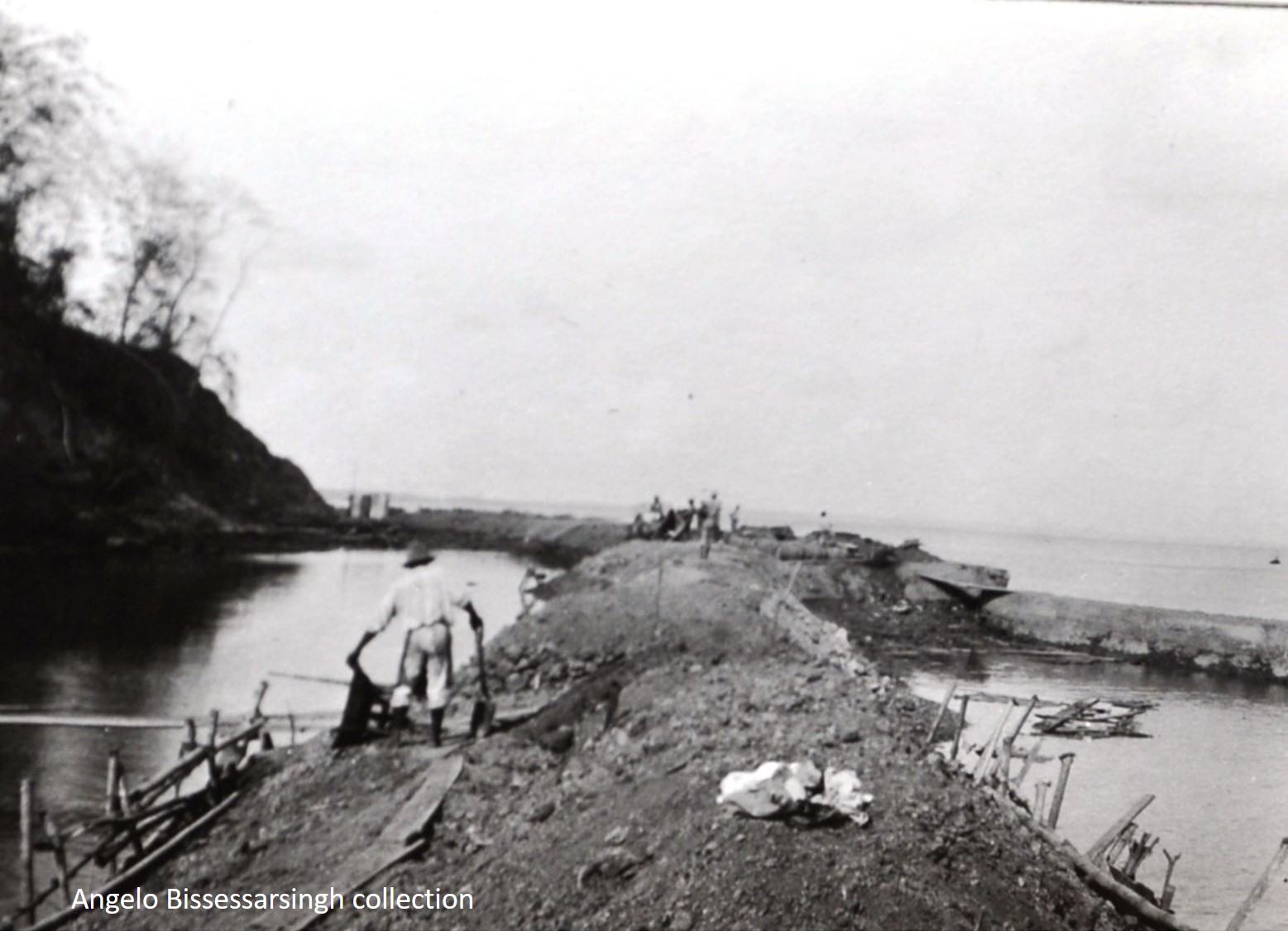
Image courtesy of the Angelo Bissessarsingh collection: The building of the san Fernando sea wall, looking south towards Bontour Point in 1912. The wall is on the right and the old beach on the left at the bottom of the cliff above which is land of the Paradise Estate.
Council Paper 179 of 1913 – Railway Extensions Report from the Chief Resident Engineer H.R. Marwood, fifth Progress Report on the San Fernando – Siparia Extension laid before Council on 10 December 1913: “Sea Wall at San Fernando: The work is now practically complete”.
Upon completion of the Sea-wall, joining the path of the San Fernando Tramway (where Independence Avenue meets Lady Hailes Avenue today) the new line continued to a junction with the Cipero Tramroad (located in the area south of Skinner Park today), then along the Cipero Tramroad to a point where said Tramroad passes through the lands of the Corinth Plantation (following the path today of the Rienzi Kirton Highway and then following a few feet north of the Cipero road), then in a South-easterly direction through lands of the Corinth and Golconda plantations, to a junction with the Siparia Railway at the commencement thereof, according to the plan of such Railway made by Horace Richard Marwood, dated 15th June, 1912, and signed by Samuel William Knaggs, Colonial Secretary, and the said Horace Richard Marwood, Chief Resident Engineer of the Trinidad Government Railway, and deposited in the office of the Sub-Intendant of Crown Lands.
The revised working estimate for the construction of the San Fernando to Siparia Line was £184,219 including new rolling stock. This against the estimate from the Consulting Engineers of £196,906. The final expenditure came in at £166,837 (about £18M in today’s money).
On 19 July 1913, His Excellency the Governor, Sir George Ruthven Le Hunte, journeyed from Port-of-Spain by special train to Siparia along with Mr. Marwood, other railway officials and representatives of the press for a preliminary inspection of the line.
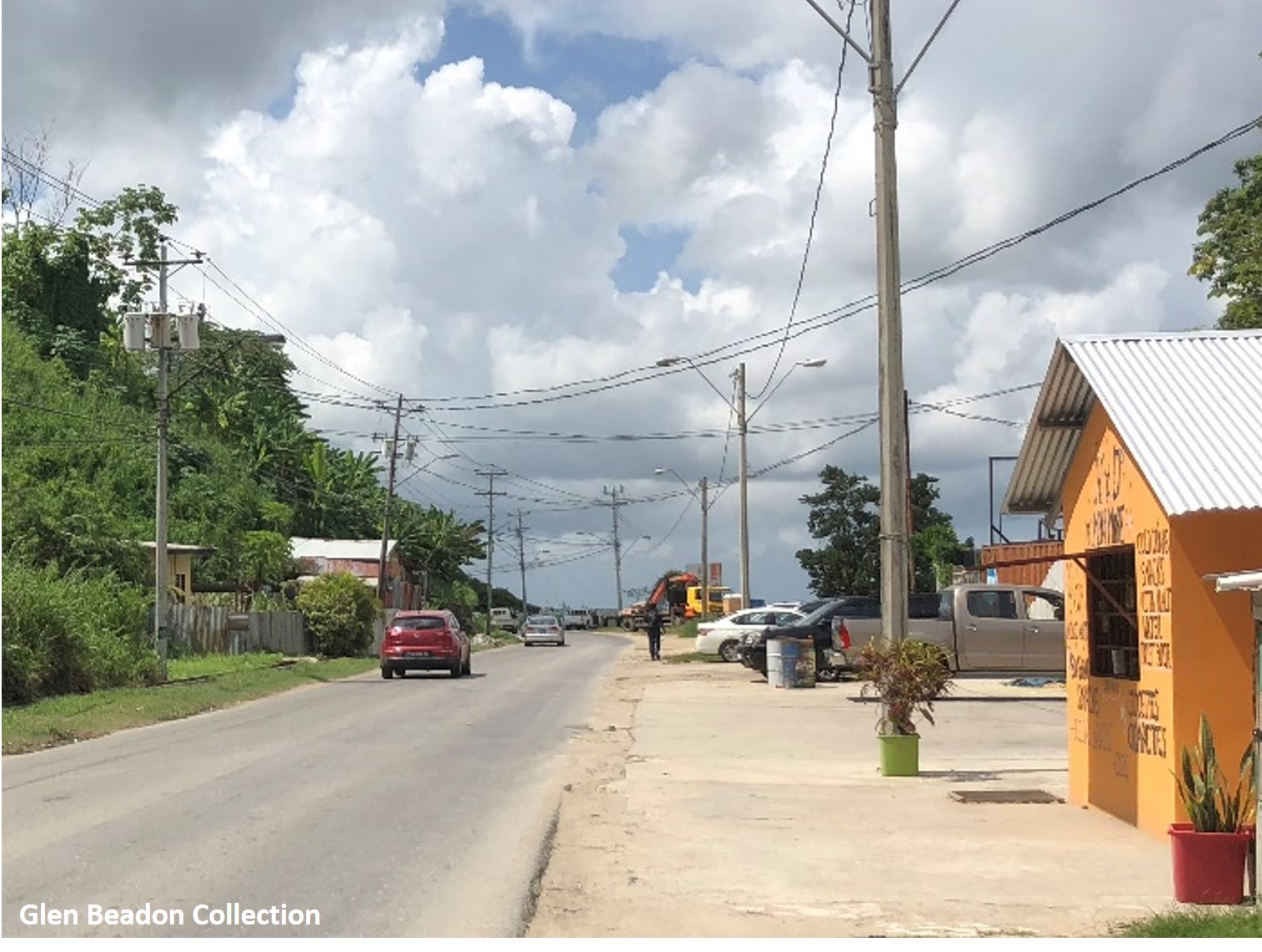
Image taken in 2018 of the same location, looking south towards Bontour point, as in the previous 1912 photograph. The seawall is to the right and what was Paradise Estate above the ridge to the left is now part of San Fernando General Hospital.
The following day, 20 July 1913 the Port of Spain Gazette reported the event: “From the City to Siparia by Train, Governor’s Inspection of the Line “was passed”, which we were told was used to supply the Usine Ste Madeline with oil which was pumped at this point from the Barrackpore oilfield, many miles away, Bravo! keep up Barrackpore!”
However, the first public passenger service along the new San Fernando Sea wall was initiated not by the Siparia service but by the Cipero Tramway to Princes Town (originally known as the “Pick-Up”) on Monday 28 August 1913. The service had not been two weeks old when on Tuesday 6 September 1913, soon after the Pick-Up had passed, a considerable portion of the sea wall collapsed, the masonry crumbling away from under the line thus leaving fifty feet of it unsupported.
The Pick-Up was once again relegated to its old route up through San Fernando while the embankment collapse was repaired. The incident caused much concern and resulted in delays to all of the extensions while a much closer look was taken at every aspect of construction.
Once the sea wall had been repaired and checked, a trial run was planned between San Fernando and Siparia. On Friday 7 November Mr H. R. Marwood, Chief Resident Engineer and General Manager of Railways, left by special train accompanied by Mr C. R. Walker, Locomotive Superintendent, for the purpose of testing the Siparia Railway extension, preparatory to the formal opening that was planned for the following week.
On 11 November 1913, the Port of Spain Gazette carried the following report on the planned opening: “For the present the trains will only run to Wilson’s (Coora) road, a short distance from the proposed Siparia terminus. The first goods train will be run down there on next Monday evening, leaving the City about 6 o’clock”.
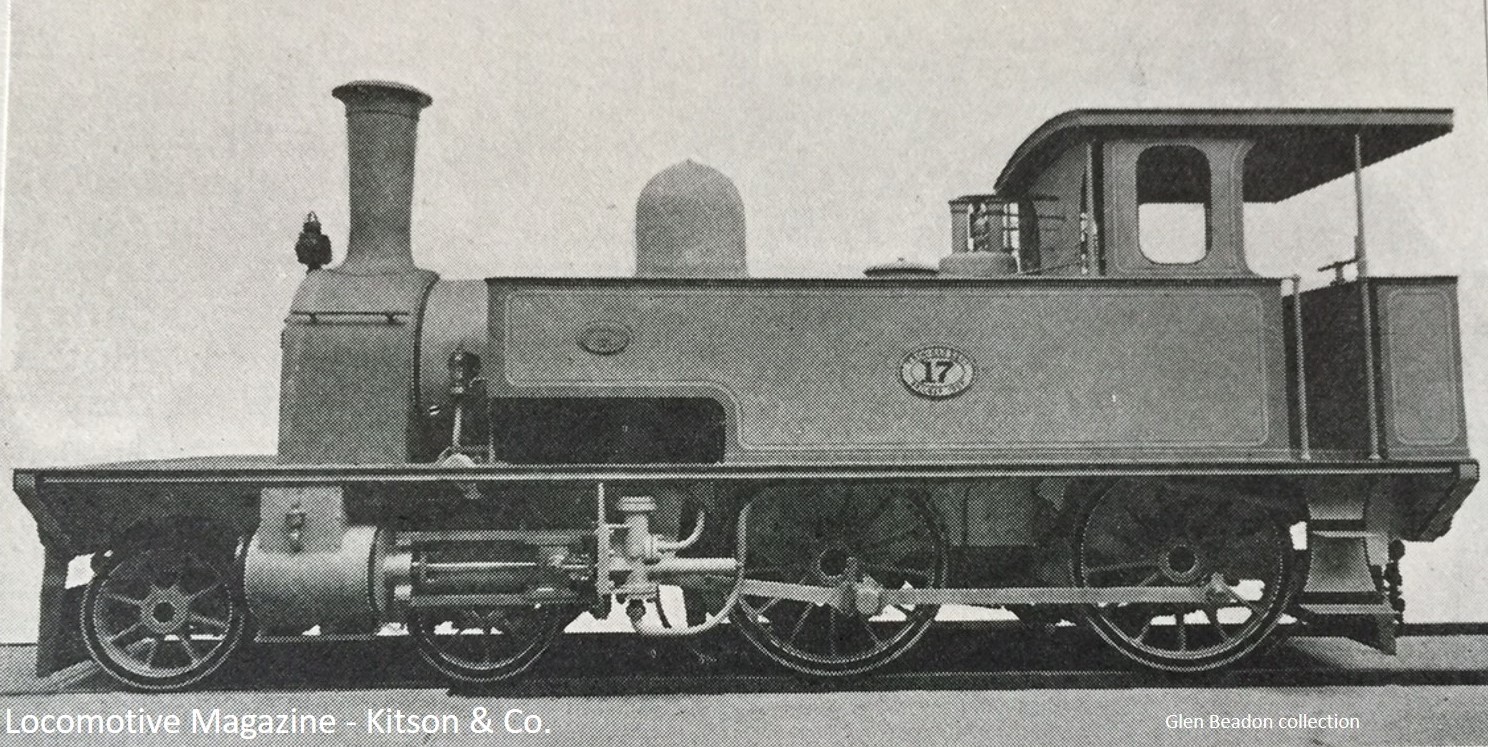
Engine No.17 which hauled the first train to Siparia on 14 November 1914 – Built by Kitson & Co of Leeds
On the 14th of November 1913, the new Siparia Line from San Fernando was opened with the running of a special train from Port-of-Spain hauled by Locomotive No.17 driven by William Adam Campbell, under the charge of head Guard Rock. The train pulled out from the City shortly after 9 o’clock, under a semi deluge of rain, and the signs were all in the direction of a rotten day for the purpose intended. The special arrived at San Fernando with His Excellency, the Governor and party at 10 a.m. The Railway Station and the wharf was decorated in a manner befitting, the Constabulary band, and Lovely Strings band in attendance.
His Worship the Mayor and Corporation of the Borough and the prominent citizens of San Fernando then boarded, and in company with the Gubernatorial party proceeded to Siparia the express conveying the very first steaming through and popping the ribbon to mark the opening of the line.
Upon arrival at Siparia, the locality was “en fete”, as part of the reception arrangements. Trucks carrying tents and water tanks for the Siparia demonstration having passed through San Fernando the previous morning.
The new Gulf Steamer, “St. Patrick”, arrived that afternoon for the first time at San Fernando harbour, and returned that evening with the Governor and party to Port-of-Spain.
Official opening of the Siparia Extension to public passenger service occurred on Monday 17 November 1913. San Fernando to Siparia calling at Corinth, Debe, Penal departed at 9.19a.m. and 1.44 p.m. Siparia to San Fernando departed at 6.03 a.m. and 10.18a.m.
When the service to Siparia was initiated the first stop out of San Fernando was Corinth. The TGR had originally planned to call this station Ste. Madeleine but made the change following suggestions by the public. Ste Madeleine instead was given to the first stop on the Cipero route into Princes Town served by the “Pick-Up” which later became known as the “Cipero Local”.
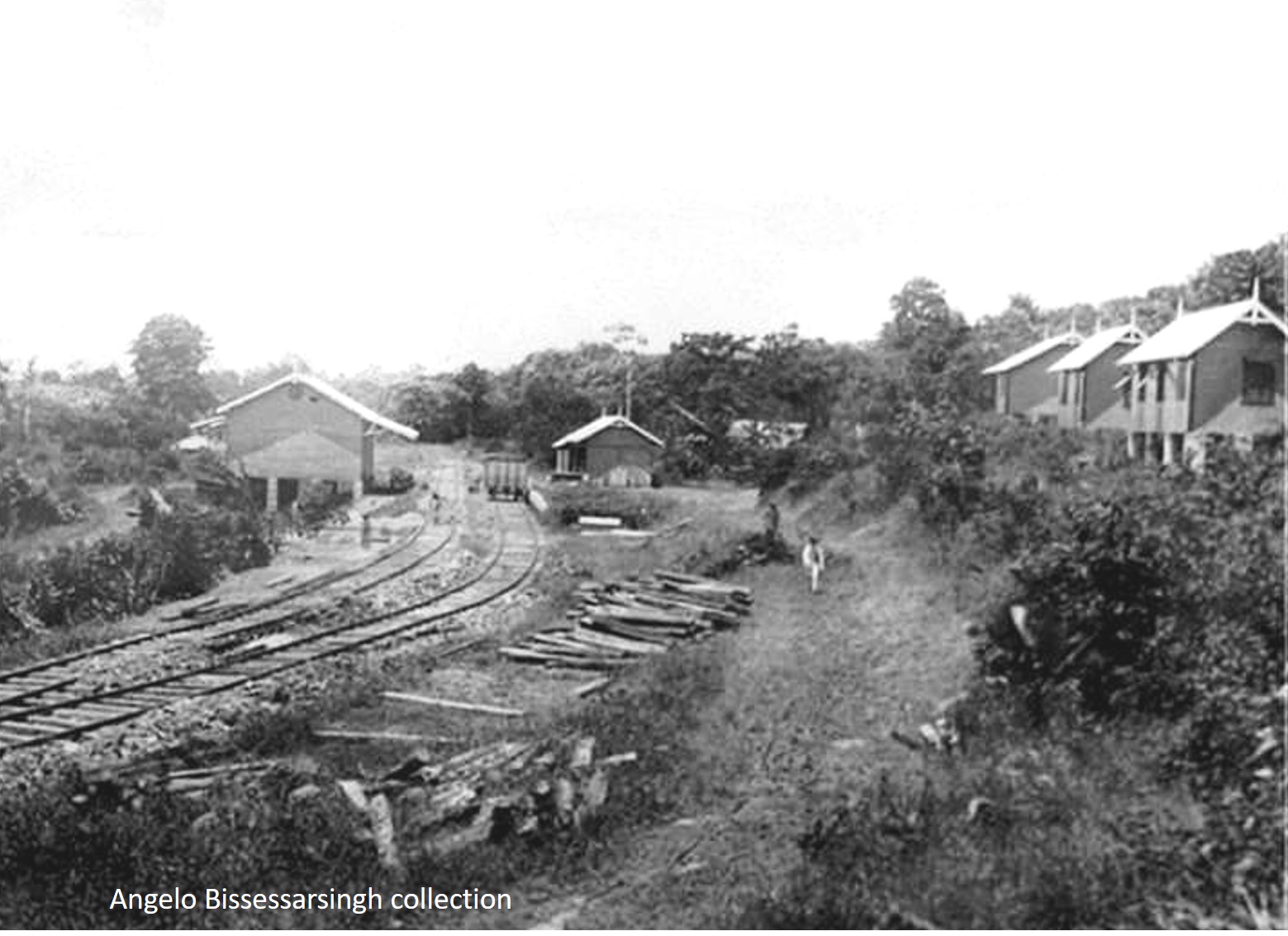
Courtesy of the Angelo Bissessarsingh collection: Penal railway station looking north towards San Fernando
By the 1930s the Siparia route had 8 stops: The Cross, Corinth, Golconda Halt, Wellington Halt, Debe, Penal, Coora halt and Siparia.
Interestingly when the TGR line to Siparia first opened it did not use the Cross as a railway station despite it being the original passenger terminus of the Cipero Tramway and therefore very first railway station in Trinidad. This situation was later corrected, and Cross Crossing became one of the best paying stations on the route.
There was also some controversy over the naming of Penal Railway Station as opposed to the traditional name of “Peñal”. The Port-of-Spain Gazette reported on 1 November 1914 the following report: “We notice that the name sign on the Peñal Railway Station is spelt Penal instead, with the result that this station will be in the near future called ‘Penal’ instead of Peñal. If the Authorities thought it worthwhile to accept the e’s in the De’be’ sign board, we think the same attention should have been paid in the Peñal station. This is necessary unless the district in future days to be associated with some penitentiary or such like institution”.
Siparia was a total of 51 miles from Port of Spain and although it had always been the plan to extend the railway to the south of the island, many inhabitants of San Fernando lamented the loss of such prestigious title of ‘terminus’.
Note: San Fernando was to become a terminus station once again in 1953 when the Siparia passenger service was discontinued. However, the line was never lifted and was to briefly reopen through to Siparia in 1964.
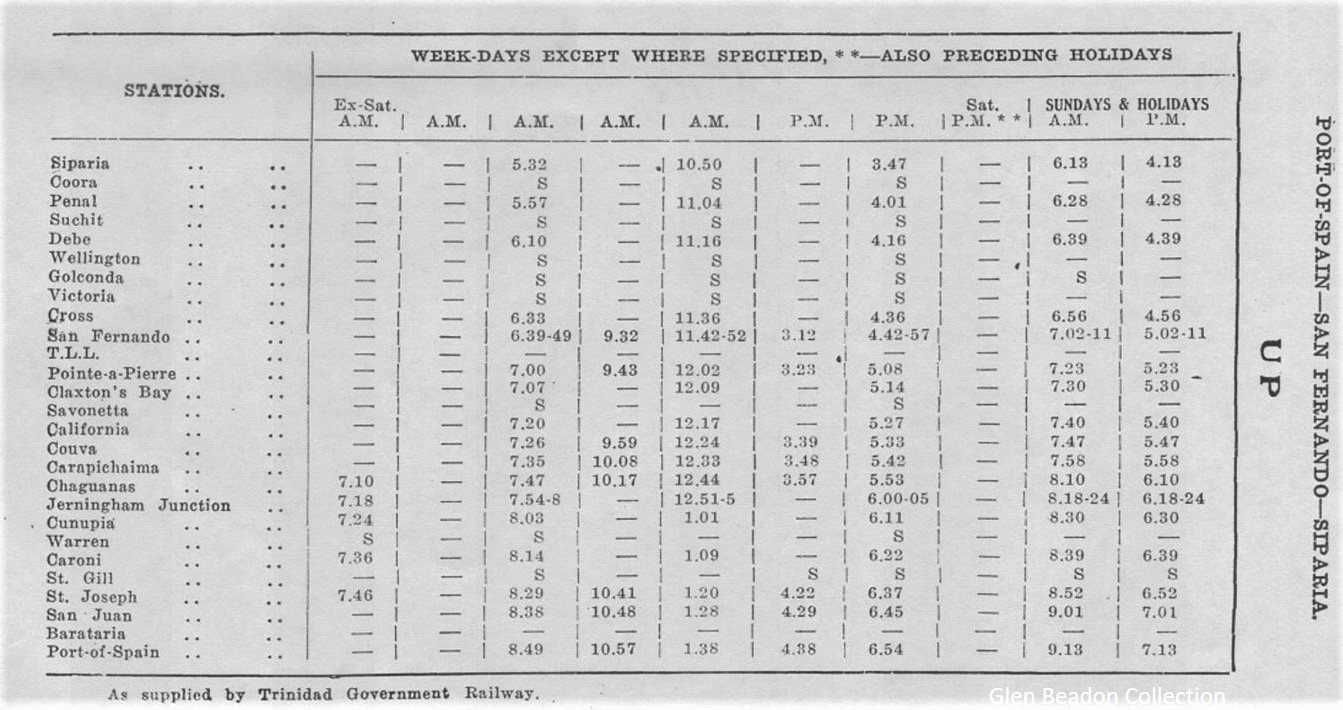
Trinidad Government Railway Timetable from the 1940’s for the Siparia line UP services
Such was the volume of rainfall over the opening two weeks the line had to be closed during the middle part of November as two locomotives became “locked in” on the Siparia end of the Railway extension and were unable to come up to San Fernando as a consequence of slips and washing away of ballast from track. During this period passengers were again forced to seek alternative travel either by cab or omnibus.
The first TGR passenger trains called at a temporary station on Coora Road. The final station, which was to become Siparia Station, did not open until Tuesday 1 April 1914.
The Port-of-Spain Gazette made the following report the next day: “As the train steamed into Siparia Station on Tuesday afternoon last for the first time, a good number of Siparia folks availed themselves of the opportunity of having the first drive to the city. They availed themselves of the return trip and arrived yesterday morning. In consequence of the heavy traffic, the train reached here several minutes behind schedule time”.
San Fernando to Siparia was a distance of 16 1/4 miles, then a journey of 67 minutes.
In 1922 the Siparia train even boasted a ‘refreshment car’ service for the three-hour run from ‘Town’. The railway proudly advertised “The choosiest assortment of drinks are retailed at ridiculously low prices. Special breakfast and lunch provided at short notice by Phoning 315”.
Trinidad’s railways were prosperous in the early years but began running into financial difficulties in the period leading up to 1920 when the TGR lost money for the first time.
World War II saw a brief revival of fortunes with increased traffic on the railway and corresponding improvement of receipts, however this was short lived.
Motor vehicle usage on the island was increasing and took more and more of the transportation market share away from the railway, forcing a permanent decline. Despite efforts to arrest this by successive administrations, by 1950 the railway was in serious trouble once again.
On the 12 March 1953 came first closure announcements on the Arima to Sangre Grande, San Fernando to Princes Town and San Fernando to Siparia lines. All of these lines were to lose their passenger services. In a twist of fate, the Siparia line was to hold on to its goods services, presumably to service the now booming oil industry.

Courtesy of the Angelo Bissessarsingh collection: Siparia railway station from the southern ridge above. There was a locomotive turntable below left out of view in the cutting. Trains did not call here until 1 April 1914, some five and a half after the opening of the new line.
In the 1950s the road system in Trinidad was not yet suitable for the transportation of heavy refinery equipment and drilling oilfield apparatus and reliance for this was placed on rail.
During the course of its life, the line brought many people to Siparia from all points of the railway network particularly during the yearly festival of La Divina Pastora when many extra trains, known as “Specials”, were put on in order to accommodate the high volume of traffic. This practice continued for several years following the withdrawal of passenger trains to Siparia in 1953.
After 1953 the railway soldiered on as a goods line with a sporadic goods service and cane specials. There was a brief resumption of a passenger service of sort in 1964 when the authorities in Siparia petitioned the need to provide transportation for school children to and from San Fernando, this service only lasted for a very short time.
The Siparia line closed for ever, along with the Southern main line and the Rio Claro line, on 30 August 1965. This however was not the end of the story for small section of the original railway between Golconda and Debe Junction. This piece of the TGR, just over half a mile in length, was taken over by the sugar industry for their own railway traffic and continued in service for another 33 years until 1998. The point which marked the beginning of the original Siparia Railway could have been preserved only a few years ago, sadly it was lost shortly before the sugar industry in Trinidad folded in 2005.
Siparia railway station on the other hand still stands today. Like so many other surviving relics of Trinidad’s late railway system, it was not the authorities that saved the buildings but members of the local community. Today the Siparia Deltones steel band keeps the old railway station in a satisfactory state of repair. Sadly, all traces of the railway lines and locomotive turntable have disappeared, but the railway cottages survive as does the old goods warehouse.
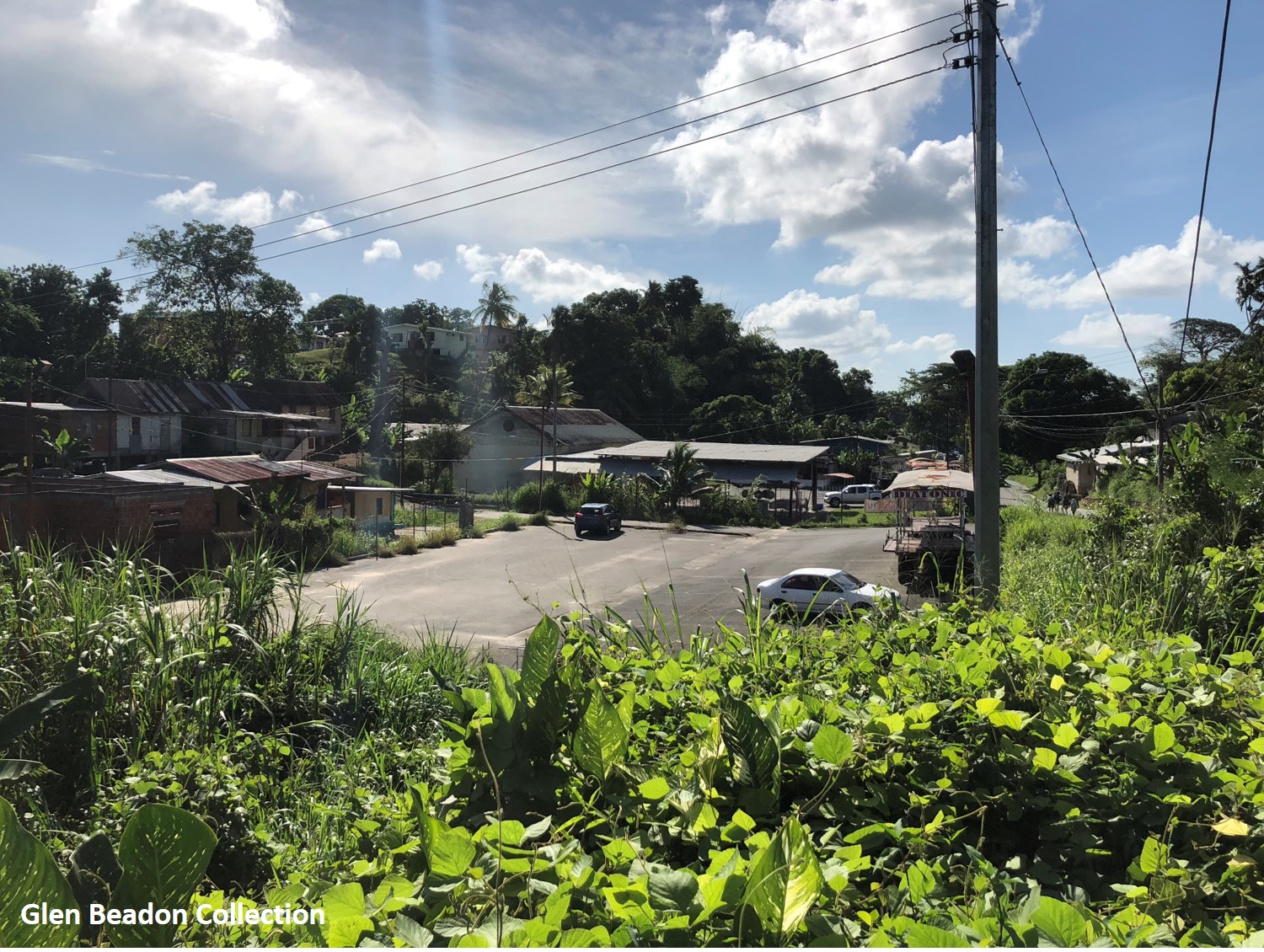
The site today of the former Penal railway station as photographed by the author in 2018. Siparia Deltones Pan Yard now occupies and cares for the site.
It must be said that the Siparia Deltones steel band, which was founded in 1962 before the total abandonment of the Siparia line, are very much aware of their railway heritage. Today the spirit of the past is still alive with subtle reminders of the railway still in evidence. In 2012 when I last visited Siparia railway station I noticed a sign bearing “Railway Road” and the “Railway Convenience store” just to remind me that I was standing at the correct location which was, quite literally, “the end of the line”.

